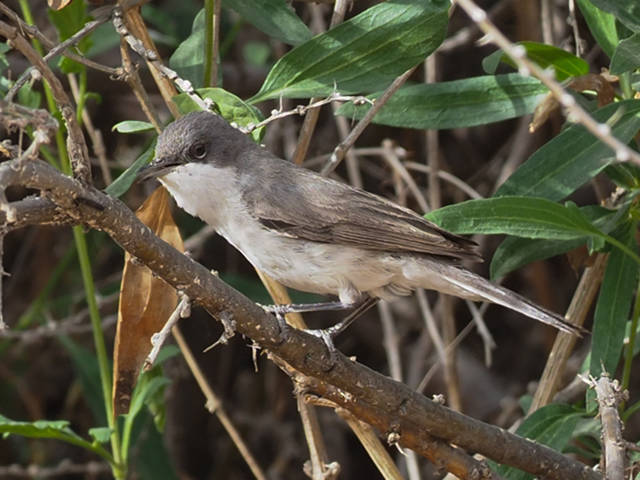search
classification
|
basic information
|
video
|
reports |
Hume's Whitethroat
Sylvia althaea (Hume, 1878)

|

|
|
|
2021-05-25
northern slope of the Terskey Ala-Too ridge |
© Aziza Abdurakhmanova
|
|
Description
The adult Hume's Whitethroats in breeding plumage are dark, slaty-grey above. Mantle sometimes have slightly brownish tinge. the flight feathers are dark-brownish. The central pair of tail feathers are black-brownish bluish tinged; the outer pair is white with the brownish shafts and the brownish patches in the base part of the inner webs; the second outer pair is black-brownish with the white terminal spots; other tail feathers are black-brownish. The lore and ear coverts are black-brownish, slightly darker than crown. The throat, breast, median part of abdomen, and undertail are off-white. The flanks are grayish. It is resemble the Lesser Whitethroat of which was formerly treated as subspecies. It is distinguished from the Lesser Whitethroat by the longer tail, longer bill and dark slaty-grey upperparts. In fresh autumn plumage the coloration is brighter. The upperparts have brown tone, crown is bluish-grey, uppertail is bluish, the ear coverts and lore are blackish; the secondaries have buffy edges, the tail feathers have the pale narrow edges. The white color of the underparts obtains the pinkish tinge especially expressed on the flanks and breast. Juveniles are almost not differed from the adults in autumn plumage. Weight 12,4 - 17.0 grams, wing 64-70, tail 56-60 mm.
Biology
The Hume's Whitethroat is common breeding migrant. It lives in mountains only. It inhabits the thickets of meadow-sweet, honeysuckle, almond-tree, dog-rose, sometimes with singles trees, rocks and junipers, at 800-2300 m. On migration it occurs in the thickets of high weed, forest-belts and gardens. Appears in the end April – early May. Nest is built in bush at 0.3-5 m high; from the grass stems, leaves and bast and is lined with the thin grass and sometimes with some hair; nest is by both parents for a week or so. Clutches of 4-5 eggs found in mid-May – early July. Both parents feed juveniles, which fledge in end the June – early August. As yet is not clear what is the cause of the long breeding period; the repeated breeding or second brood in season. Autumn migration is probable in August. Latest autumn migrants recorded 15 August 1963 in Talasskiy Alatau, and on mid-September in Tajikistan.
References
"Птицы Казахстана" том 4. "Наука", Алма-Ата. 1972. Gavrilov E. I., Gavrilov A. E. "The Birds of Kazakhstan". Almaty, 2005. Э.И.Гаврилов. "Фауна и распространение птиц Казахстана". Алматы, 1999.





